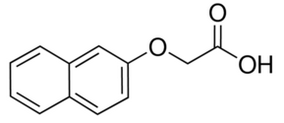(BNOA)β-NAPHTHOXYACETIC ACID β—萘氧基乙酸
Introduction: Used as plant hormone to promote the growth of roots, to encourage fruit set and to prevent fruit from falling prematurely.
Common name: (BNOA)β-Naphthoxyacetic Acid
Another name: (2-naphthyloxy)acetic acid, 2-naphthoxyacetic acid, etc.
Chemical name: 2-naphthoxyacetic acid
Empirical formula: C12H10O3
Structural formula:

Mol. Weight: 202.21 g/mol
CAS No.: 120-23-0
Specifications
Leading (BNOA)β-Naphthoxyacetic Acid supplier
(BNOA)β-Naphthoxyacetic Acid 98% TC
Packing:
BULK PACKING
Solid: 25kg/Bag, 25kg/Drum, 50kg/Drum etc.
SMALL PACKING
Solid: 1kg/Alu bag, 500g/Alu bag, 200g/Alu bag, 100g/Alu bag, 50g/Alu bag, 15g/Alu bag etc.
Customerized packing label
Professional registration
HAZARDS IDENTIFICATION
Hazard statement(s)
H302 (100%): Harmful if swallowed.
H315 (93.75%): Causes skin irritation.
H319 (93.75%): Causes serious eye irritation.
H335 (90.62%): May cause respiratory irritation.
Precautionary statement(s)
P261: Avoid breathing dust/fume/gas/mist/vapors/spray.
P264: Wash ... thoroughly after handling.
P270: Do not eat, drink or smoke when using this product.
P271: Use only outdoors or in a well-ventilated area.
P280: Wear protective gloves/protective clothing/eye protection/face protection.
P301+P312: IF SWALLOWED: call a POISON CENTER/doctor/... IF you feel unwell.
P302+P352: IF ON SKIN: wash with plenty of water.
P304+P340: IF INHALED: Remove person to fresh air and keep comfortable for breathing.
P305+P351+P338: IF IN EYES: Rinse cautiously with water for several minutes. Remove contact lenses if present and easy to do - continue rinsing.
P312: Call a POISON CENTER or doctor/... if you feel unwell.
P321: Specific treatment (see ... on this label).
P330: Rinse mouth.
P332+P313: IF SKIN irritation occurs: Get medical advice/attention.
P337+P313: IF eye irritation persists: Get medical advice/attention.
P362: Take off contaminated clothing.
P403+P233: Store in a well-ventilated place. Keep container tightly closed.
P405: Store locked up.
P501: Dispose of contents/container to ...
Supplemental Hazard Statements: none
MAMMALIAN TOXICOLOGY
Acute toxicity: 1) Acute oral LD50 for rat: 1417 a.i.mg/kg. 2) Acute dermal LD50 for rat: >2000 a.i.mg/kg. 3) Inhalation LC50 (4 h) for rat: >4.87 a.i.mg/L. 4) Cause skin irritation (rabbits). 5) Cause serious eye irritation (rabbits). 6) Skin sensitisation (guinea pigs): based on available data, the classification criteria are not met.
No classification data on carcinogenic properties of this material is available from EPA, IARC, NTP, OSHA or ACGIH.
ADI: 0.01 mg/kg b.w./day [Rat, SF=1000]
Classification:
Toxicity class WHO (a.i.): II (Moderately hazardous)
US EPA Classification (formulation): III (Caution - Slightly toxic)
EC Risk Classification: Xn - Harmful: R22; Xi - Irritant: R36/37/38
ECOTOXICOLOGY
Effect on birds: low toxicity to birds, acute oral LD50 for Japanese quail is >2000 a.i.mg/kg. Effect on fish: moderate toxicity to fish, acute 96 hour LC50 for Rainbow trout is 2.39 a.i.mg/L. Effect on aquatic invertebrates: moderate toxicity to aquatic invertebrates, acute 48 hour EC50 for Daphnia magna is >4.52 a.i.mg/L. Effect on algae, low toxicity to algae, acute 72 hour EC50 for Desmodesmus subspicatus is 29 a.i.mg/L. Effect on honeybees: low toxicity to honeybees, contact acute 48 hour LD50 is >200 a.i.μg/bee. Effect on earthworms: low toxicity to earthworms (as formulation, product conc 4.5% a.s.), acute 14 day LC50 is >1000 mg/kg.
ENVIRONMENTAL FATE
β-Naphthoxyacetic Acid's production may result in its release to the environment through various waste streams; its use as a plant growth regulator will result in its direct release to the environment. If released to air, a vapor pressure of 2.89×10-3 mPa at 25 deg C indicates β-Naphthoxyacetic Acid will exist solely in the particulate phase in the atmosphere. Particulate-phase β-Naphthoxyacetic Acid will be removed from the atmosphere by wet or dry deposition. If released to soil, β-Naphthoxyacetic Acid is expected to be mobile based upon an estimated Koc of 72.0. Volatilization from moist soil surfaces is not expected to be an important fate process based upon an estimated Henry's Law constant of 1.06×10-4 Pa m3/mol. β-Naphthoxyacetic Acid is not expected to volatilize from dry soil surfaces based upon its vapor pressure. EU dossier DT50 lab studies range 18.1-100.5 days, DT90 range 10-443 days. If released into water, β-Naphthoxyacetic Acid is expected to adsorb to suspended solids and sediment based upon the estimated Koc. Volatilization from water surfaces is not expected to be an important fate process based upon this compound's estimated Henry's Law constant. LogP < 3 suggests the potential for bio-concentration in aquatic organisms is low.
Usage: β-Naphthoxyacetic acid is a naphthalene-based auxin, absorbed via root and leaf. It can promote fruit set, stimulate fruit erlargement and prevent hollow fruits. It can also stimulate root formation when co-used with rooting agent.
Application: Naphthylacetic acid (BNOA) is a naphthalene plant growth regulator with auxin bioactivity, absorbed by leaves and roots. Can promote fruit, stimulate the fruit to expand, and can overcome the hollow fruit; with the root agent used together, but also to promote plant rooting.Used as a plant growth stimulant, used to improve the pineapple, strawberry, tomato fruit rate and adjust the growth
| 






